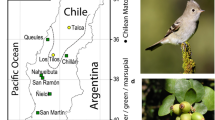Summary
Fruiting phenology and pattern of fruit removal of two shrubby dogwoods were examined in relation to fruit composition. It was predicted that fruit of the species bearing high fat fruit would disappear more rapidly and fall to the ground sooner than fruit of the species bearing low fat fruit. Field observation at two sites in central Pennsylvania contradicts these predictions. C. racemosa fruit, containing relatively high concentrations of crude fat, were retained on plants longer and fell into fruit traps later than c. amomum fruit, containing relatively low concentrations of crude fat. A substantial portion of the crops of both species fell under plants and most fallen fruit were secondarily removed. Potential explanations for patterns observed in this study are discussed.
Similar content being viewed by others
References
Allen SE (1974) Chemical Analysis of Ecological Materials. Halsted Press, New York
Baird JW (1980) The selection and use of fruit by birds in an eastern forest. Wilson Bull 92:63–73
Berlocher SH (1984) A new North American species of Rhagoletis (Diptera: Tephritidae), with records of host plants of Cornus-infesting Rhagoletis. J Kansas Entomol Soc 57:237–242
Borowicz VA, Juliano SA (1985) Fruit density and the intensity of parasitism by Rhagoletis fruit flies in Cornus amomum. Bull Ecol Soc Am 66:144
Bush GL (1966) The taxonomy, cytology, and evolution of the genus Rhagoletis in North America (Diptera, Tephritidae). Bull Museum Comp Zool 134:431–562
Finney DJ (1952) Probit analysis. Cambridge University Press, Cambridge
Gleason HA, Cronquist A (1963) Manual of vascular plants of northeastern United States and adjacent Canada. Van Nostrand, New York
Hamilton WJ (1941) The food of small forest mammals of eastern United States. J Mammal 22:250–263
Herbes SE, Allen CP (1983) Lipid quantification of freshwater invertebrates: method modification for microquantitation. Can J Fish Aquat Sci 40:1315–1317
Herrera CM (1982) Defense of ripe fruit from pests: its significance in relation to plant-disperser interactions. Am Nat 120:218–241
Herrera CM, Jordano P (1981) Prunus mahaleb and birds: the high-efficiency seed dispersal system of a temperature fruiting tree. Ecol Monogr 51:203–218
Janzen DH (1977) Why fruits rot, seeds mold, and meat spoils. Am Nat 111:691–713
Leopold AS, Jones SE (1947) A phenological record for Sauk and Dane Counties, Wisconsin, 1935–1945. Ecol Monogr 17:83–122
Lindeman RH, Merenda PF, Gold RZ (1980) Introduction to bivariate and multivariate analysis. Scott, Foresman and Co, Glenview, Illinois
Martin AC, Zim HS, Nelson AL (1968) American wildlife and plants: a guide to wildlife food habits. Dover Press, New York
Neter J, Wasserman W (1974) Applied linear models. Irwin, Homewood, Illinois
Rust RW, Roth RR (1981) Seed production and seedling establishment in the mayapple, Podophyllum peltatum L. Am Midl Nat 105:51–60
Salomonson MG, Balda RB (1977) Winter territoriality of Townsend's Solitaires (Myadestes townsendii) in a pinon-juniper-ponderosa pine ecotone. Condor 79:148–161
SAS Institute Inc (1982) SAS User's Guide: Statistics, 1982 Edition. SAS Institute Inc. Cary, Illinois
Schmidt-Nielsen K (1975) Animal Physiology. Cambridge University Press, New York
Sherburne CA (1972) Effects of seasonal changes in abundance and chemistry of the fleshy fruits of northeastern woody shrubs and patterns and exploitation by frugivorous birds. Unpublished Ph. D. thesis, Cornell University
Snow DW (1971) Evolutionary aspects of fruit-eating by birds. Ibis 113:194–202
Snow DW (1981) Coevolution of birds and plants. In: PL Forey (ed) The evolving biosphere. Cambridge University Press, Cambridge, pp 169–178
Stiles EW (1980) Patterns of fruit presentation and seed dispersal in bird disseminated woody plants in the eastern deciduous forest. Am Nat 116:670–688
Thompson JN, Willson MF (1979) Evolution of temperature fruit/bird interactions: phenological strategies. Evolution 33:973–982
Willson MF, Thompson JN (1982) Phenology and ecology of color in bird-dispersed fruit, or why some fruits are red when they are “green”. Can J Bot 60:701–713
Wood M (1967) Birds of Pennsylvania. The Pennsylvania State University, College of Agriculture, University Park, PA
Author information
Authors and Affiliations
Rights and permissions
About this article
Cite this article
Borowicz, V.A., Stephenson, A.G. Fruit composition and patterns of fruit dispersal of two Cornus spp.. Oecologia 67, 435–441 (1985). https://doi.org/10.1007/BF00384952
Received:
Issue Date:
DOI: https://doi.org/10.1007/BF00384952




